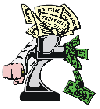INFORMATION ARTICLE

 |
A Free $350,000 House (By John D. Behle, EMS) |
|
Just
for fun let me show you a deal that will blow your mind. Lay
back and fantasize for a while. Come along for the ride and
see if it jump starts your greed glands. I control the
vertical. I control the horizontal. The deal is real. The
profits are realistic.
At times, I like to show people the potential beyond their current position. A little like showing you a picture of Chateau Lake Louise in Waterton, Alberta, Canada - even though you may currently be driving though the desert in Arizona. Itís on the road, just some miles away. If it makes your brain hurt, donít worry, it did the same for me when I needed to bring in the investors and explain it to them. Some deals are harder to explain than they are to understand. Itís easy to know that a deal is profitable (especially when you get something for free), but sometimes it takes massive spreadsheet calculations to show someone else how much. The "Paper Trade" It started with a standard "paper trade" scenario. We just had too many deals on the table at the moment and not enough un-encumbered paper (most of it was financed at very attractive rates). The "Paper trade" in itís simplest format is buying notes at a discount and then trading them at full face value for real estate equities. I buy a $100,000 note for $70,000 (30% discount) and then use it as collateral to buy a $100,000 house. I end up buying the house at 70% of market value. Most of the time the "Trade" takes the form of using the note (or notes) as collateral - a term called "hypothecation." $100,000 Property Value $100,000 Note used as collateral (Hypothecated) $ 70,000 Cost of note purchased and used as collateral $ 70,000 New loan taken out on purchased property Results: $100,000 Property $ 70,000 First loan - new loan from Last National Bank ------------------------------------------------------------------------------------------- $ 30,000 Equity - that didnít cost a cent To get the cash needed, I finance the property for $70,000 and it becomes a nothing down deal at 70% of value with a positive cash flow. A "Collateral Rental" Since we didnít have the notes we needed at the time, and because I donít like to pass up a good deal, I suggested the creation of new notes on an investors real estate equity. In other words, we buy the property using seller financing that is created against the equity in the investorís property. This concept is called a "collateral rental." The investor puts up his equity and has as security the equity in the house that is being purchased. The investor gets a 3% rate of return on his un-productive "dead" equity and has no cash invested. That is not 3% interest, it is a 3% spread on borrowed money (equity). Little risk is involved, because the investor has the house as collateral also. So, the numbers on the deal look like this: $350,000 FMV of property $300,000 Sales Price $ 30,000 Down Payment $270,000 Balance The $270,000 Balance is a note to be created against an investorís property. Terms of the note are 9% interest, payable $2172.48 per month for 360 months. I execute a compensating note to the investor secured by the property being purchased for the same amount with a 12% rate (resulting in a 3% spread). This results in a payment to the investor of $2,777.25 per month and a resulting net profit of $604.77 per month for the investor. Remember, the investor has no cash invested and is fully collateralized. For an added cushion on this deal, to make payments for the first year (and to make it a 100% free property) we pull $40,000 in cash out of the property with a new loan. We also pull the $30,000 down payment out, resulting in a new first loan of $70,000. The investorís note is in a second position, but has the added security of the cash cushion (of 40k) - in the bank. Now, the long term plan is to acquire the notes to use as collateral instead of the investorís property. This is a "Substitution of Collateral" technique. In other words, when the notes are available, they are used as collateral and the investorís property is released. The "LOC Twist" When checking into the financing, (through our in house conventional mortgage company) we found a new program that is an "equity line of credit" with no points, few closing costs and 9.375% interest - up to 90% LTV on the property. In other words, the lender is effectively giving us a credit card to buy notes with and a $315,000 limit. I like that. As a note becomes available (at a discount of 30% or more), the line of credit is used to purchase the note or notes. The notes can later be used in one of two manners. One is to substitute collateral to free up the investors property (the collateral rental) and the other use could be to use the income from the note to offset the payments. The higher yield on the notes makes it a profitable deal, along with the discount in the fair market value. Even after the cost of the collateral rental, the property will cost below 70% of value with nothing down and no payments for the first year. Next, Iíll show you how to cover the payments on the second through the 30th years so that the property is 100% free. Portfolio Turnover and Improvement When the paper is purchased and substituted, the investor will be out of the picture. He received his rent for his equity (You can rent a rental twice!) and has been paid out and his property is now unsecured. We are left with a note of $270,000 secured by $270,000 (or more) in existing real estate paper (notes). As you may know, the average 30 year note goes about 4.2 years. Letís assume that these notes are long term notes and according to the 4.2 year number, 25% of the portfolio will experience the process of "Refunding". This process is the dread of CMO based mutual funds, and the greatest reward to discounted paper investors. In other words, the notes will pay off at face value and result in a profit to us. Why? The profit comes from the fact that we can again substitute paper with the previous home owner that took the seller financing. Letís say one of the notes in the portfolio is for $75,000 and pays off at face value. Yes, itís collateralized, but could we take $50,000 and buy another $75,000 note to use as collateral (substitution). That leaves us a profit of $25,000 to make payments for year number two. The next year, the same process occurs. Those are the "natural" statistics. Portfolio turnover and enhancement can be over 50% per year when the portfolio is actively worked. Encouraging payoffs and using over 117 different techniques to improve notes and enhance their yields results in extraordinary profits. Weíre working on an even nicer deal right now. A land developer puts up his land as a collateral rental for the purchase of a single family "fixer." The line of credit (LOC) on the home is then used to draw upon to buy the paper created as the developer sells lots. A 30% discount on the created paper leads to a great yield and an eventual substitution of collateral for the holder of the seller financing that is created by the purchase of the single family home. The home is purchased effectively at 70% of value. After modernization and sale of the single family home, there should be a profit of over 100,000 dollars with nothing invested other than some "Brain Equity." About the Author . . . John D. Behle is one of the foremost educators and practitioners in the field of discounted paper investment. His innovative strategies and techniques have shaped the industry. With over two decades in the industry and an extensive background in real estate and finance, John Behle adds a wealth of knowledge and experience to his creative money-making techniques.John holds an National Council of Exchangors "Gold Card" and an EMS designation. He is also listed in Who's Who In Creative Real Estate. John Behle is the author of several hundred articles published in national magazines and newsletters and of several ground-breaking real estate paper books, including: * The Paper Game Trilogy |
|
![]() To
Fax this article to someone else for free click on the
box.
To
Fax this article to someone else for free click on the
box.
Home
Free Articles